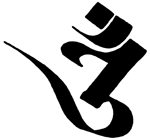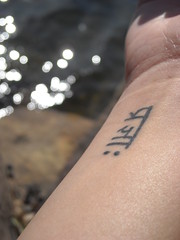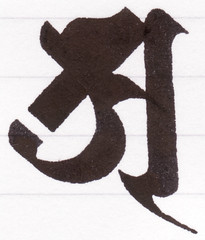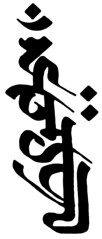visits to the site - 154,519; up 62% from 2008
page loads - 484,360; up 30% from 2008
Most popular mantra - Vajrasattva - 22,315 pageloads. Also no.1 2008.
The Facebook Visible Mantra page now also has 1003 fans.
Thanks everyone for making this website a success.
31 December 2009
17 December 2009
Offering Mantra
Gino recently asked about the offering mantra used during the maṇḍala offering practice. I thought other people might be interested in this as well.
The mantra reads:
If we take this to be a Sanskrit sentence then the words guru and ratna are undeclined suggesting that they are part of a compound: gururatnamaṇḍalakaṃ. So how should be parse this compound? Firstly the individual words: guru = teacher; ratna = jewel; maṇḍalaka is a variant of maṇḍala. The -ṃ ending would appear to match the idaṃ and be an accusative making idaṃ gururatnamaṇḍalakaṃ the object of the verb. I suggest that we take ratnamaṇḍalaka to be a tatpuruṣa - maṇḍala of jewels. Then it would make some sense for this to make a tatpuruṣa with 'guru', but perhaps of the dative kind, 'to or for the guru' rather than the standard genitive 'of the guru'. Looking at the context I think this fits what is being done in practice.
The verb comes from the root √yat 'to stretch'. What we have here is a causative form: yātayati which can mean 'to suffer', or in this case 'to yield up' or 'surrender'. The first person singular is yātayāmi 'I surrender'. The addition of the prefix nir- here indicates that one is giving up to others. Of Monier-Williams' suggestions 'to give back, to restore' seem to fit the context, he notes the sense of 'to give as a present' in the Lalitavistara Sūtra.
So we could render the phrase
The mantra reads:
idaṃ guru-ratna-maṇḍalakaṃ niryātayāmi
इदं गुरुरत्नमण्डलकं निर्यातयामि
(above in dbu-can)
इदं गुरुरत्नमण्डलकं निर्यातयामि
(above in dbu-can)
If we take this to be a Sanskrit sentence then the words guru and ratna are undeclined suggesting that they are part of a compound: gururatnamaṇḍalakaṃ. So how should be parse this compound? Firstly the individual words: guru = teacher; ratna = jewel; maṇḍalaka is a variant of maṇḍala. The -ṃ ending would appear to match the idaṃ and be an accusative making idaṃ gururatnamaṇḍalakaṃ the object of the verb. I suggest that we take ratnamaṇḍalaka to be a tatpuruṣa - maṇḍala of jewels. Then it would make some sense for this to make a tatpuruṣa with 'guru', but perhaps of the dative kind, 'to or for the guru' rather than the standard genitive 'of the guru'. Looking at the context I think this fits what is being done in practice.
The verb comes from the root √yat 'to stretch'. What we have here is a causative form: yātayati which can mean 'to suffer', or in this case 'to yield up' or 'surrender'. The first person singular is yātayāmi 'I surrender'. The addition of the prefix nir- here indicates that one is giving up to others. Of Monier-Williams' suggestions 'to give back, to restore' seem to fit the context, he notes the sense of 'to give as a present' in the Lalitavistara Sūtra.
So we could render the phrase
idaṃ guru-ratna-maṇḍalakaṃ niryātayāmi
I offer up this jewel-maṇḍala to the guru
I offer up this jewel-maṇḍala to the guru
Labels:
Mantra
15 December 2009
Tendai Studies and Art Symposium
If you live in California then this is an amazing opportunity to hear and meet some of the great names in Buddhist studies including John Stevens author of Sacred Calligraphy of the East (without which none of this website would exist!). There will be an exhibit of Tendai calligraphy from April 1 to June 1 2010.
07 December 2009
Stryi and the Karaṇḍamudrā Dhāraṇī
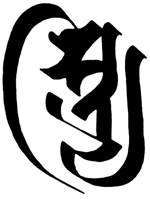 Back in Feb 2009 I was intrigued by a complex seed-syllable seen carved on the side of a Japanese stūpa. I could see the Siddhaṃ elements but wanted to understand the context. Eventually, with a little luck, I managed to identify the bīja as stryi which is associated with an important Japanese liturgical text: the Karaṇḍamudrā Dhāraṇī. I put some notes into this blog, but have now put this material on its own page: Karaṇḍamudrā Dhāraṇī and stryi.
Back in Feb 2009 I was intrigued by a complex seed-syllable seen carved on the side of a Japanese stūpa. I could see the Siddhaṃ elements but wanted to understand the context. Eventually, with a little luck, I managed to identify the bīja as stryi which is associated with an important Japanese liturgical text: the Karaṇḍamudrā Dhāraṇī. I put some notes into this blog, but have now put this material on its own page: Karaṇḍamudrā Dhāraṇī and stryi.At some point I want to do some Siddhaṃ calligraphy of the dhāraṇī itself, but here at least you can see where the syllable stryi originates from.
Some other versions of stryi can be seen in this Flickr Gallery: Stone Siddhaṃ.
13 November 2009
Tadyathā in the Heart Sūtra

tadyathā
http://jayarava.blogspot.com/2009/10/tadyatha-in-heart-sutra.html
12 November 2009
Men who stare at calligraphy
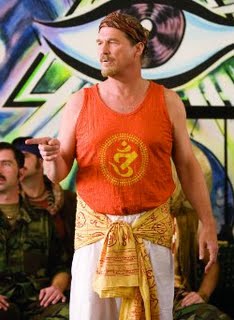 In the movie The Men Who Stare at Goats Jeff Bridges character is twice seen wearing a singlet with a large Siddhaṃ oṃ on it - see left.
In the movie The Men Who Stare at Goats Jeff Bridges character is twice seen wearing a singlet with a large Siddhaṃ oṃ on it - see left.See also my version of oṃ on Flickr.
Labels:
Siddham
08 November 2009
Mystery Amulet
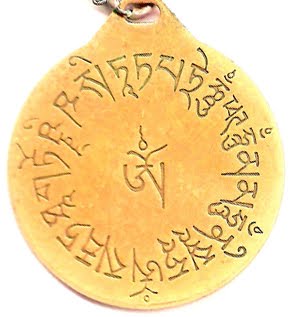 Nigel sent in this image of his amulet and asked about the mantra on it. The mantra is in the Tibetan Uchen (dbu-can) script. In the centre is the seed-syllable (bījākṣara) oṃ. The mantra starts at 6 c'clock and goes clockwise. It reads
Nigel sent in this image of his amulet and asked about the mantra on it. The mantra is in the Tibetan Uchen (dbu-can) script. In the centre is the seed-syllable (bījākṣara) oṃ. The mantra starts at 6 c'clock and goes clockwise. It readsoṃ sarvatathāgatoṣṇīṣasitātapatre hūṃ phaṭ hūṃ mama hūṃ ni svāhāIf we break the sandhi and add dashes for compounds it reads:
oṃ sarva-tathāgataḥ
uṣṇīṣa-sita-ātapatre hūṃ phaṭ hūṃ mama hūṃ ni svāhā
So now it becomes clear that this is a mantra for Uṣṇīṣa-sitātapatra (also spelt Uṣṇīṣa-sitātapattra) a Tantric goddess with 1000 heads, 1000 arms, and 1000 legs! Her name means something like 'crowned with a white parasol'. Her iconography is very complex, though apart from her multiple limbs she does carry a white (sita) umbrella/parasol (ātapatra) or sometimes a Tibetan victory banner. Robert Thurman tells us that she is a special form of Tārā and a counter part to the 100o armed form of Avalokiteśvara (The Sacred Art of Tibet p.319-321).
Here's the mantra written out in dbu-can.

Try here for an image of Uṣṇīṣa-sitātapatra.
Nigel made a generous donation for receiving this information - thanks again!
Labels:
Queries
07 November 2009
YouTube
Just found a new cache of Siddhaṃ calligraphy on YouTube (thanks to Riccardo's Facebook page Bonji 梵字 - Riccardo is a bit naughty and has been taking images from here without asking, but I'm sure we can sort something out). These are quite interesting examples which from the accompanying text and commentary are from Japan.
The Fudō Bīja hāmmāṃ
The Mahāvairocana Seed Syllable vāṃḥ
Note here that the calligrapher makes an error. He writes ba instead of va. The two are very similar. In ba the curve curls back to meet the stem on the up-stroke, whereas on the va it continues down to the stem on the down-stroke. These letters are similar in most Indic scripts: cf Devanāgarī ब व. Indeed they are often confused in pronunciation as well.
The Fudō Bīja hāmmāṃ
The Mahāvairocana Seed Syllable vāṃḥ
Note here that the calligrapher makes an error. He writes ba instead of va. The two are very similar. In ba the curve curls back to meet the stem on the up-stroke, whereas on the va it continues down to the stem on the down-stroke. These letters are similar in most Indic scripts: cf Devanāgarī ब व. Indeed they are often confused in pronunciation as well.
Labels:
Calligraphy,
Siddham,
YouTube
03 November 2009
Arapacana Monogram
I was asked about doing a Kalacakra style monogram by someone and so have been playing around. Arapacana seemed the obvious choice to do. Seeing all those tails hanging down it seemed like a good idea to braid them.
I quite like the result and may do more - though it's quite painstaking getting it to fit.
I quite like the result and may do more - though it's quite painstaking getting it to fit.
30 October 2009
The Hundred Syllable Vajrasattva Mantra
 My latest post on Jayarava's Raves is some notes on a translation of the 100 Syllable Vajrasattva Mantra. I also offer some commentary on the words, though I plan to write a longer piece on this. I've also replaced the translation on the Visible Mantra Vajrasattva page.
My latest post on Jayarava's Raves is some notes on a translation of the 100 Syllable Vajrasattva Mantra. I also offer some commentary on the words, though I plan to write a longer piece on this. I've also replaced the translation on the Visible Mantra Vajrasattva page.I worked on this for my book project (still lumbering on) but couldn't wait to share it. The version of the mantra I'm commenting on is the one in the FWBO Puja Book
On the 12th of Dec I'm running a workshop at the Cambridge Buddhist Centre where we will study the Sanskrit text and then chant the mantra. Book online by visiting the CBC Website.
Happy Halloween - the Vajrasattva mantra is just what you need to keep the ghouls and ghosts away!
oṃ vajrasattvasamayamanupālaya vajrasattvatvenopatiṣṭha dṛḍho me bhava sutoṣyo me bhava supoṣyo me bhava anurakto me bhava sarva siddhiṃ me prayaccha sarvakarmasu ca me cittaṃ śreyaḥ kuru hūṃ ha ha ha ha hoḥ bhagavan sarvatathāgatavajra mā me muñca vajrī bhava mahāsamayasattva āḥ
Labels:
Commentary,
Sanskrit,
Vajrasattva
27 October 2009
Unwise Tattoo?
Saw this on Flickr. The word for wisdom is prajñā - a feminine noun in -ā.
This person has: प्रज्ञाः prajñāḥ
Prajñāḥ is the nominative plural: wisdoms. Whoops.
This person has: प्रज्ञाः prajñāḥ
Prajñāḥ is the nominative plural: wisdoms. Whoops.
Labels:
Tattoo
10 October 2009
Karanīya Mettā Sutta
This is the well known Karanīya Mettā Sutta from the Suttanipāta (Sn 143-152). More info on my Flickr Site - click the image to find it.
I offer this version to offset the unskilful things I've done, said and thought in the last couple of weeks. Please feel free to copy this and spread it around.
My website has the Roman text and my translation. I've done another more colloquial translation. Also I've done a partial commentary. There are many translations online, each with its own merits.
I offer this version to offset the unskilful things I've done, said and thought in the last couple of weeks. Please feel free to copy this and spread it around.
My website has the Roman text and my translation. I've done another more colloquial translation. Also I've done a partial commentary. There are many translations online, each with its own merits.
14.6.10
I've not also translated an exert from the commentary to the Karanīya Mettā Sutta which explains the circumstances in which the Buddha gave the discourse: How the Karanīya Mettā Sutta Came About.
Labels:
Calligraphy,
Pali,
Sutra
30 September 2009
Tattoo - spot the mistakes!
Anyone who knows a little about Lantsa or Ranjana should be able to spot the mistakes in this man's tattoo - I spotted three errors in the characters visible, but then I've been typing up Lantsa mantras for a couple of weeks using the CBETA font and the SiddhaṃKey input system. My comments on the mantra are on the original site - click on the image to see them.
21 September 2009
ye dharma hetu prabhava
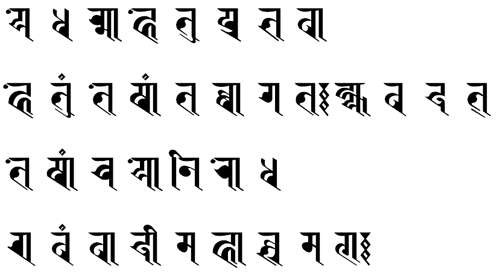 Replaced Tibetan, and added images of Lantsa (left), Sinhala (Pāli) scripts to the Ye dharma page. This phrase is often called the Buddhist credo (Latin: I believe)
Replaced Tibetan, and added images of Lantsa (left), Sinhala (Pāli) scripts to the Ye dharma page. This phrase is often called the Buddhist credo (Latin: I believe)Ye dharmā hetuprabhavā hetuṃ teṣāṃ tathāgataḥ hyavadat teṣāṃ ca yo nirodha evaṃ vādī mahāśramaṇaḥ
Labels:
updates
20 September 2009
New Logo
 Some of you will notice that I've created a new logo for the site - this is partly in preparation for the publication of the book of the website. The character is dma. In Sanskrit 'visible mantra' would be darśataḥ mantraḥ giving the initials D.M. Combined into one bīja you get dma.
Some of you will notice that I've created a new logo for the site - this is partly in preparation for the publication of the book of the website. The character is dma. In Sanskrit 'visible mantra' would be darśataḥ mantraḥ giving the initials D.M. Combined into one bīja you get dma.
Labels:
updates
18 September 2009
Couple of Websites to Look at
These two websites may be of interest:
Mật Tông - Vietnamese Esoteric Buddhism
Some interesting Lantsa calligraphy here - most of the site is in Vietnamese but the visual stuff is good.
Siddham & Ranjana Keyboard
When this first launched I wasn't impressed. I don't like the CBETA Siddhaṃ font for start. But recently I re-visited the site and it seems to have come a long way. What really interested me was the input method for Ranjana and a decent Ranjana font. It's pretty good except for the spacing - it seems as though the letters are about 200% too wide so can't be grouped together to write words or mantras. (I used a character spacing of -20pts in Word and got a better, if slightly uneven, result). The Ranjana font isn't Unicode (I think conjuncts are displayed using individual characters rather than ligatures), and there are some gaps (dhīḥ and tāṃ can't be input for instance). However its a good start and the results are certainly better than my shakey calligraphy!
Mật Tông - Vietnamese Esoteric Buddhism
Some interesting Lantsa calligraphy here - most of the site is in Vietnamese but the visual stuff is good.
Siddham & Ranjana Keyboard
When this first launched I wasn't impressed. I don't like the CBETA Siddhaṃ font for start. But recently I re-visited the site and it seems to have come a long way. What really interested me was the input method for Ranjana and a decent Ranjana font. It's pretty good except for the spacing - it seems as though the letters are about 200% too wide so can't be grouped together to write words or mantras. (I used a character spacing of -20pts in Word and got a better, if slightly uneven, result). The Ranjana font isn't Unicode (I think conjuncts are displayed using individual characters rather than ligatures), and there are some gaps (dhīḥ and tāṃ can't be input for instance). However its a good start and the results are certainly better than my shakey calligraphy!
Labels:
Lantsa,
recommended
12 September 2009
Evil Tattoo
A friend posted this on his Facebook page and I thought it would make a good cautionary tale:
12/9 Noticed this Kelly Osbourne interview today:
A Buddhist, who’s more faith than reason, into all things tantric, spots the paṁ syllable in a purification practice. He goes along to the local tattoo parlour and has it tattooed on his shoulder blade.
He's showing it off to a friend who reads the practice and says: 'It says here that paṁ is the seed syllable for all evil.'
'Oh, I’ve got the seed syllable for all evil tattooed on my shoulder blade.' Sad, but true.
My response was that he might reassure his friend by reminding him that paṃ is also the bīja for Paṇḍāravāsinī, plus I think evil would have to be pāṃ (from the first syllable of the Sanskrit word pāpa). This is one case where diacritics matter!
12/9 Noticed this Kelly Osbourne interview today:
"I hate my tattoos. I saw someone about getting a couple removed, especially the keyboard, because I don't even know how to play the piano and I was drunk when I got it. I was a spiteful brat who got tattoos to piss off my mum and now I think they are ugly. People define you by tattoos and I don't want to be defined by an anchor on my arm! Unfortunately, having them removed is going to be painful."
Labels:
Tattoo
09 September 2009
06 September 2009
Amitāyus
I have re-evaluated my Sanskrit re-creation of the Amitāyus mantra from the Tibetan, which is on the Amitābha page. The Tibetan reads (in Unicode)
This is usually transliterated: om amarani dziwantaye soha which reflects Tibetan pronunciation. The actual syllables are: oṃ ā ma ra ṇi dzi wan te ye svā hā, from which I have now reconstructed the Sanskrit:
More details and Siddhaṃ calligraphy on the Amitābha page. Ideally I'd find a Sanskrit source for this mantra to clarify the matter - if you know one please let me know.
ཨོཾ༌ཨཱ༌མ༌ར༌ནི༌ཛི༌ཝན༌ཏེ༌ཡེ༌སྭཱ༌ཧཱ།
This is usually transliterated: om amarani dziwantaye soha which reflects Tibetan pronunciation. The actual syllables are: oṃ ā ma ra ṇi dzi wan te ye svā hā, from which I have now reconstructed the Sanskrit:
oṃ amaraṇi jīvantaye svāhā
ओं अमरणि जीवन्ताये स्वाहा
ओं अमरणि जीवन्ताये स्वाहा
More details and Siddhaṃ calligraphy on the Amitābha page. Ideally I'd find a Sanskrit source for this mantra to clarify the matter - if you know one please let me know.
Labels:
corrections,
updates
05 September 2009
Padmasambhava
Alerted to a minor error on the Padmasambhava page I have updated it. I've replaced the the Siddhaṃ calligraphy, and the Tibetan calligraphy (with a font based image), but I've also added some material that I had prepared for the forthcoming Visible Mantra book (don't hold your breath). Now you will also find the Thöthrengtsal or Skull Garland mantra, and the Seven Line Invocation - both in Uchen and transliterated - with Saṅgharakṣita's translation of the latter which is based on the oral explanation he received from Dhardo Rinpoche. Both of these are popularly chanted in the FWBO.
Labels:
updates
02 September 2009
100,000 Visitors
Earlier today visiblemantra.org topped 100,000 visits for 2009 which is very gratifying, especially as I haven't done much work on the site lately. Thanks everyone!
100,000 visitors have downloaded more than 320,000 pages with the Vajrasattva page being the most popular by a long way. 2% - which is, like, 2000 sessions - have looked at more than 100 pages - 10 out of 10 for perseverance whoever you are.
Work on turning the site into an attractive book is progressing rather slowly, but it is progressing. That work will eventually translate back into the site with vastly improved Tibetan, and Devanāgarī for everything. I'm hoping to get hold of a good Lantsa font before too long as well.
100,000 visitors have downloaded more than 320,000 pages with the Vajrasattva page being the most popular by a long way. 2% - which is, like, 2000 sessions - have looked at more than 100 pages - 10 out of 10 for perseverance whoever you are.
Work on turning the site into an attractive book is progressing rather slowly, but it is progressing. That work will eventually translate back into the site with vastly improved Tibetan, and Devanāgarī for everything. I'm hoping to get hold of a good Lantsa font before too long as well.
Vajrasattva Mantra
Vajrasattva: I replaced my rough Tibetan Calligraphy of hūṃ and oṃ vajrasattva hūṃ with images created using fonts. Much better! I've also added the 100 syllable mantra in Unicode - here it is again:
ཨོཾ་བཛྲ་སཏྭ་ས་མ་ཡ་མ་ནུ་པ་ལ་ཡ།
བཛྲ་སཏྭ་ཏྭེ་ནོ་པ་ཏིཥྛ། དྲྀ་ཌྷོ་མེ་བྷ་བ། སུ་ཏོ་ ཥྱོ་མེ་བྷ་བ།
སུ་པོ་ ཥྱོ་མེ་བྷ་བ། ཨ་ནུ་ར་ཀྟོ་མེ་བྷ་བ། ས་རྦ་སི་དྡྷི་མེ་པྲ་ཡ་ཙྪ།
ས་རྦ་ཀ་རྨ་སུ་ཙ་མེ ཙི་ཏྟཾ༌ཤེ་ཡཿ་ཀུ་རུ་ཧཱུྂ།
ཧ་ཧ་ཧ་ཧ་ཧོཿ བྷ་ག་བ་ན ས་རྦ ཏ་ཐཱ་ག་ཏ་བཛྲ་མཱ་མེ་མུ་ཉྩ།
བཛྲཱི་བྷ་བ་མ་ཧཱ་ས་མ་ཡ་སཏྭ ཨཱཿ །།
ཧཱུྂ ཕ་ཊ
You can use this (ie cut and paste) to display the mantra using any Unicode font which has the Tibetan range - such as Tibetan Machine Uni, or Microsoft Himalaya. There are a number of other fonts around. Note that the 100 syllables end with āḥ - hūṃ and phaṭ are added for special purposes - see the page for explanations. Note also that there are variations in the spelling and my version is my best attempt to convey the Sanskrit using Uchen.
ཨོཾ་བཛྲ་སཏྭ་ས་མ་ཡ་མ་ནུ་པ་ལ་ཡ།
བཛྲ་སཏྭ་ཏྭེ་ནོ་པ་ཏིཥྛ། དྲྀ་ཌྷོ་མེ་བྷ་བ། སུ་ཏོ་ ཥྱོ་མེ་བྷ་བ།
སུ་པོ་ ཥྱོ་མེ་བྷ་བ། ཨ་ནུ་ར་ཀྟོ་མེ་བྷ་བ། ས་རྦ་སི་དྡྷི་མེ་པྲ་ཡ་ཙྪ།
ས་རྦ་ཀ་རྨ་སུ་ཙ་མེ ཙི་ཏྟཾ༌ཤེ་ཡཿ་ཀུ་རུ་ཧཱུྂ།
ཧ་ཧ་ཧ་ཧ་ཧོཿ བྷ་ག་བ་ན ས་རྦ ཏ་ཐཱ་ག་ཏ་བཛྲ་མཱ་མེ་མུ་ཉྩ།
བཛྲཱི་བྷ་བ་མ་ཧཱ་ས་མ་ཡ་སཏྭ ཨཱཿ །།
ཧཱུྂ ཕ་ཊ
You can use this (ie cut and paste) to display the mantra using any Unicode font which has the Tibetan range - such as Tibetan Machine Uni, or Microsoft Himalaya. There are a number of other fonts around. Note that the 100 syllables end with āḥ - hūṃ and phaṭ are added for special purposes - see the page for explanations. Note also that there are variations in the spelling and my version is my best attempt to convey the Sanskrit using Uchen.
Labels:
updates,
Vajrasattva
01 September 2009
Sabbe Satta Sukhi Hontu
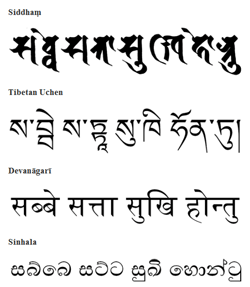 Thanks to stumble.com the page with my decorative version of the Pāli mantra sabbe sattā sukhi hontu has become one of the most popular pages on visiblemantra.org. As a result I have spruced up the sister page - May all beings be happy - which shows the mantra in formal siddhaṃ (new calligraphy), and added versions in Tibetan (Uchen), Devanāgarī and Sinhala - using images of fonts to spare you my ragged calligraphy in those scripts (screen shot left).
Thanks to stumble.com the page with my decorative version of the Pāli mantra sabbe sattā sukhi hontu has become one of the most popular pages on visiblemantra.org. As a result I have spruced up the sister page - May all beings be happy - which shows the mantra in formal siddhaṃ (new calligraphy), and added versions in Tibetan (Uchen), Devanāgarī and Sinhala - using images of fonts to spare you my ragged calligraphy in those scripts (screen shot left).I've discovered a good utility for transcribing Sinhala so will be adding that script for other Pāli phrases - if you know of one for Burmese and Thai let me know.
31 August 2009
New Mantra
Caught up with Tashi Mannox on a recent visit to London which was cool. He gave me a calligraphy of a mantra I hadn't come across before. It is used in the conclusion of Tibetan sadhanas.
So after doing some research and consulting him about the Tibetan writing and pronunciation I've added the first new page to visiblemantra.org for some time. I'm calling it the supratiṣṭha mantra for want of a better name. The page has Siddhaṃ, Uchen and Devanāgarī.
So after doing some research and consulting him about the Tibetan writing and pronunciation I've added the first new page to visiblemantra.org for some time. I'm calling it the supratiṣṭha mantra for want of a better name. The page has Siddhaṃ, Uchen and Devanāgarī.
25 June 2009
Tattoos
Every now and then I get a fun request for a tattoo and this mornings effort is a gem of the genre.
I'll start the bidding with: बष्वुल्, डक्, डौपी, ग्रंपी, हप्पी, स्लीपी, स्नीसी
"I was wondering if you guys could translate the Seven Deadly sins and the Seven Holy Virtues into Buddhist Sanskrit for me. I want to tattoo it on my back."Given that he won't be able to read the result - what would you write on his back? Must be in lots of seven!
I'll start the bidding with: बष्वुल्, डक्, डौपी, ग्रंपी, हप्पी, स्लीपी, स्नीसी
24 June 2009
Sword with Fudō Bīja and a mystery
 Richard sent me this pic of a Japanese sword asking if the symbols are Siddhaṃ. They are, but there is a bit of a mystery. The top two symbols are hāṃ and maṃ which are both associated with Fudō Myōō.
Richard sent me this pic of a Japanese sword asking if the symbols are Siddhaṃ. They are, but there is a bit of a mystery. The top two symbols are hāṃ and maṃ which are both associated with Fudō Myōō.The bottom syllable looks like Siddhaṃ as well but it is so stylised that I can't read it. Taking a guess I think it might be some variation on 'a' because that would fit what I know about Fudō and his association with Mahāvairocana of whom the 'a' is the bīja. My guess is that it is āṃḥ - the elaborate variation that includes a, ā, aṃ, and aḥ symbolising the four stages of the spiritual path in the Mahāvairocana Abhisaṃbodhi Tantra.
If you know for sure what it is please let me know and I'll pass it on. The original photo is here.
Labels:
Mysteries
16 June 2009
aṃ
 'GBH' asked on the blog about this form of the seed syllable aṃ which is an image in the Japanese Wikipedia commons. The text accompanying it is in Japanese but it appears the the image was scanned from a book called 悉曇章の研究 (and is therefore a breach of copyright!)
'GBH' asked on the blog about this form of the seed syllable aṃ which is an image in the Japanese Wikipedia commons. The text accompanying it is in Japanese but it appears the the image was scanned from a book called 悉曇章の研究 (and is therefore a breach of copyright!)This is simply a variety Siddhaṃ. It looks like it was either done with a Chinese Calligraphy brush or is designed to look that way. Note that even contemporary Siddhaṃ calligraphy can vary quite widely in style.
 Compare with my pen style 'a' (left, and here) - the shape is the same: a shape like a number 3 linked by a mid-height line to a vertical stroke on the right. The contemporary a in Devanāgarī is similar as well: अं. The dot above the aṃ is the basic anusvāra which indicates nasalisation of the vowel. Anusvāra (anu + svāra) means after-sound, or following sound. Often with bīja mantras the anusvāra is exchanged for the chandra-bindu (moon and dot) which has the same phonetic effect, but which involves a more elaborate symbollism.
Compare with my pen style 'a' (left, and here) - the shape is the same: a shape like a number 3 linked by a mid-height line to a vertical stroke on the right. The contemporary a in Devanāgarī is similar as well: अं. The dot above the aṃ is the basic anusvāra which indicates nasalisation of the vowel. Anusvāra (anu + svāra) means after-sound, or following sound. Often with bīja mantras the anusvāra is exchanged for the chandra-bindu (moon and dot) which has the same phonetic effect, but which involves a more elaborate symbollism.
01 June 2009
Readers' Work
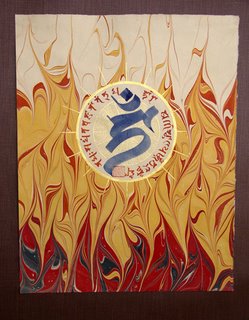 Seishin recently sent me an example of his work - inspired by visiblemantra.org. This is a fine piece of work on many levels. The flame effects are hand-made marbled paper, while the calligraphy is done with a specially ground pen and a flat brush - for the hāṃ. This is the bīja and mantra of Acala Vidyarāja or Fudō Myōō as he is known in Japanese.
Seishin recently sent me an example of his work - inspired by visiblemantra.org. This is a fine piece of work on many levels. The flame effects are hand-made marbled paper, while the calligraphy is done with a specially ground pen and a flat brush - for the hāṃ. This is the bīja and mantra of Acala Vidyarāja or Fudō Myōō as he is known in Japanese.This is a stunning setting for the mantra and an interesting combination of East and West. As I wrote to Seishin - the cool blue of the hāṃ amidst the hot yellow and red flames invokes one of the fundamental Buddhist metaphors: the coolness of nirvāṇa
I'm more than happy to see, and to showcase other people's work if anyone wants to send any in.
Labels:
Readers Work
21 May 2009
Onmyoji 3 & 4
 The Manga Onmyoji 4 has just been published in French translation by Patrick Honnore. You may recall that I was helping Patrick transliterate the mantras used in the comic which are written in the Siddhaṃ script. I also worked on Onmyoji 3.
The Manga Onmyoji 4 has just been published in French translation by Patrick Honnore. You may recall that I was helping Patrick transliterate the mantras used in the comic which are written in the Siddhaṃ script. I also worked on Onmyoji 3.The mantras in the comic are used by tantric wizards, often to subdue demons. So if you read French and like mangas check it out.
Sometime back on this blog I asked for info about some obscure mantras but never heard anything. In Onmyoji 3 the Fudo mantra is featured - which is what made me create a Fudo page for visiblemantra.org.
Labels:
Onmyoji,
publications,
updates
22 April 2009
wheel-of-letters
Someone asked me what the wheel of Sanskrit letters sometimes found in Buddhist visualisations practices would look like. So here's something I knocked up with Word using Devanāgarī.
The inner circle is the vowels, middle is the consonants (including kṣa) and the outer circle is the famous phrase: ye dharmā hetuprabhava hetuṃ teṣaṃ tathāgataḥ hyavadat, teṣaṃ ca yo nirodha - evaṃ vādī mahāśramaṇaḥ. The latter is often included in the visualisation practices. All start at 12 o'clock.
I think however that the vowels and consonants should be going in different directions - so this is just to give you an idea and is not definitive. I plan to do a definitive version in Siddhaṃ at some point.
The inner circle is the vowels, middle is the consonants (including kṣa) and the outer circle is the famous phrase: ye dharmā hetuprabhava hetuṃ teṣaṃ tathāgataḥ hyavadat, teṣaṃ ca yo nirodha - evaṃ vādī mahāśramaṇaḥ. The latter is often included in the visualisation practices. All start at 12 o'clock.
I think however that the vowels and consonants should be going in different directions - so this is just to give you an idea and is not definitive. I plan to do a definitive version in Siddhaṃ at some point.
16 April 2009
Updates
I've updated the calligraphy for Vajrasattva and the Heart Sūtra. Also updated the notes on the Heart Sūtra and linked to my synopsis of Jan Nattier's article on where the sūtra was composed (China rather than India almost certainly). I added the Uchen script the Śuddha mantra (aka the Śunyata Mantra) - using an image of the font Tibetan Machine Uni which I have resorted to instead of calligraphy.
13 April 2009
Tashi Mannox
I note that Tashi Mannox now has a blog which goes into some of the background to his very excellent Tibetan calligraphy. The address is inkessential.blogspot.com. Some very interesting material there already!
10 April 2009
White Tārā
I've recently updated the notes on the White Tārā mantra in accordance with a new understanding of Sanskrit. Not all ambiguities are able to be resolved, but at least it is now clear what is ambiguous and in what way. I've changed the way I present the variations on the mantra. My previous efforts were too dependent on books, and have again benefited from my Sanskrit studies.
Much remains to be done in this vein, although it is important to recall that mantras are not entirely translatable and that this kind of approach is limited. The White Tārā mantra is somewhat unusual in containing grammatical sensible phrases.
Much remains to be done in this vein, although it is important to recall that mantras are not entirely translatable and that this kind of approach is limited. The White Tārā mantra is somewhat unusual in containing grammatical sensible phrases.
28 March 2009
Words
 I've updated the words section, replacing the relatively scruffy miscellaneous collection of calligraphy with a more consistent style, and add a number of new words.
I've updated the words section, replacing the relatively scruffy miscellaneous collection of calligraphy with a more consistent style, and add a number of new words.I haven't had any requests in this section for a while, so if there is something you would like me to add, please say so.
Labels:
updates
26 March 2009
Kālacakra
Saw an interesting version of the Kālacakra monogram in Tibetan script on Flickr and decided to have a go at a Siddhaṃ version. I think the result is quite pleasing, and it is as far as I know unique. The syllables included are: haṃ kṣaḥ ma la va ra ya.
More info on the Kālacakra Monogram
More info on the Kālacakra Monogram
24 March 2009
17 March 2009
Heart Sūtra Mantra
A keen tattoo enthusiast noticed an error in my Siddhaṃ Heart Sūtra Mantra, and so I've updated it, and replaced the appalling Tibetan with a pic of it done with a font (Tibetan Machine Uni if you're interested). So far rendering Tibetan in browsers is a bit hit and miss, so I'll stick to images. Georg Fisher of Indian Scripts in Tibet says he's going to make his gorgeous Lantsa fonts available so eventually I might have some decent Lantsa mantras here as well.
Also since I've just covered past-participles in Sanskrit I've updated my Heart Sūtra mantra notes on the mess that is exegesis of the word 'gate'. I wrote something related on my blog recently as well: Words in Mantras that End in -e.
Also since I've just covered past-participles in Sanskrit I've updated my Heart Sūtra mantra notes on the mess that is exegesis of the word 'gate'. I wrote something related on my blog recently as well: Words in Mantras that End in -e.
Labels:
updates
07 March 2009
Dumb Tattoos
I sometimes cop some flak for saying that I think tattoos are dumb. I'm mainly referring to people who want tattoos of mantras/words/syllables they don't understand the significance of, in scripts they don't read, in languages they don't speak. Some of the consequences of this approach to body adornment can be seen on this blog: Hanzi Smatter - "dedicated", the subtitle reads, "to the misuse of Chinese characters in Western culture". Tattoos feature highly on this site. One man's tattoo doesn't mean "Dragon Soul" as he thinks, but simply "foreigner". A model for AussieBum underwear seems to have inadvertently tattooed himself with "determined to cut down something big", etc. Need I say more?
Labels:
Tattoo
15 February 2009
Kurukullā
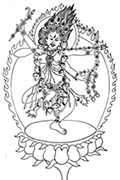 I've added a new page for the first time in a while. This one is for the Tantric figure Kurukullā, who is associated with the Red Rite, or the Rite of Fascination. She resembles a ḍakiṇī in form and is distinguished by the fact that she is drawing back a bow with an arrow fitted - both of which are covered in flowers.
I've added a new page for the first time in a while. This one is for the Tantric figure Kurukullā, who is associated with the Red Rite, or the Rite of Fascination. She resembles a ḍakiṇī in form and is distinguished by the fact that she is drawing back a bow with an arrow fitted - both of which are covered in flowers.
Labels:
updates
08 February 2009
A couple of stray mantras
Of the thirteen principle Buddhas and Bodhisattvas of the Shingon school I have pages for eleven. The two that are missing are Mahāsthāmaprāpta and Samantabhadra, neither of whom have the same popularity (at least in these forms) in the West as they do in Japan. In some schools of Tibetan Buddhism Samantabhadra becomes the Adibuddha, that is he takes Mahāvairocana's role.
In anycase until I get around to creating pages for these two, here are their mantras in siddhaṃ with Roman, Devanāgarī, and, as an experiment, Tibetan (note the Tibetan is Unicode but you might need to find a Tibetan font as the Tibetan range isn't often included in standard fonts. I use Tibetan Machine Uni)
Mahāsthāmaprāpta (Seishi Bosatsu) महास्थामप्राप्त

oṃ saṃ jaṃ jaṃ saḥ svāhā
ओं सं जं जं सः स्वाहा
ཨོཾ་སཾ་ཇཾ་ཇཾ་སཿ་སྭཱ༌ཧཱ།
Note: Her bīja is saḥ सः སཿ
Samantabhadra (Fugen Bosatsu) समन्तभद्र
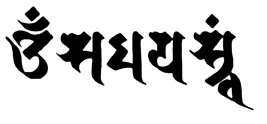
oṃ sa ma ya stvaṃ i.e. oṃ samayas tvaṃ
ओं समयस्त्वं
ཨོཾ་ས་མ་ཡ་སྠྭཾ།
Note:
samaya is an agreement or contract, the nominative singular is samayaḥ which changes to samayas when followed by the t of tvaṃ meaning you, also nom. sg. So that part means "you are bound", or "there is an agreement or contract with you". It probably refers to the tantric vows one takes before abhiṣeka.
Samantabhadra's bīja is aṃ अं ཨཾ
Do let me know how the Tibetan looks as I want to start using it more extensively.
In anycase until I get around to creating pages for these two, here are their mantras in siddhaṃ with Roman, Devanāgarī, and, as an experiment, Tibetan (note the Tibetan is Unicode but you might need to find a Tibetan font as the Tibetan range isn't often included in standard fonts. I use Tibetan Machine Uni)
Mahāsthāmaprāpta (Seishi Bosatsu) महास्थामप्राप्त

oṃ saṃ jaṃ jaṃ saḥ svāhā
ओं सं जं जं सः स्वाहा
ཨོཾ་སཾ་ཇཾ་ཇཾ་སཿ་སྭཱ༌ཧཱ།
Note: Her bīja is saḥ सः སཿ
Samantabhadra (Fugen Bosatsu) समन्तभद्र

oṃ sa ma ya stvaṃ i.e. oṃ samayas tvaṃ
ओं समयस्त्वं
ཨོཾ་ས་མ་ཡ་སྠྭཾ།
Note:
samaya is an agreement or contract, the nominative singular is samayaḥ which changes to samayas when followed by the t of tvaṃ meaning you, also nom. sg. So that part means "you are bound", or "there is an agreement or contract with you". It probably refers to the tantric vows one takes before abhiṣeka.
Samantabhadra's bīja is aṃ अं ཨཾ
Do let me know how the Tibetan looks as I want to start using it more extensively.
06 February 2009
Seed Syllable: Stryi
This seed-syllable often seen carved onto stūpas in Japan is associated with the Karaṇḍamudrā or Casket Seal dhāraṇī. This texts begins:
For more information see the stryi bīja page on visiblemantra.org
Broken down into syllables for writing this becomes:namastryadhvikānāṁ sarva tathāgatānāṁ
homage to all the Tathāgatas of the three times.
na ma strya dhvi kā nāṁ
For more information see the stryi bīja page on visiblemantra.org
Subscribe to:
Comments (Atom)


